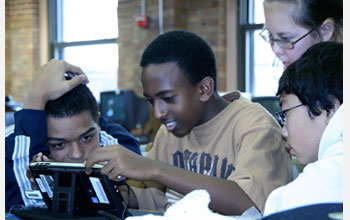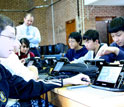|

Press Release 08-090
State of Play

A computer game is part of Oklahoma's comprehensive approach to building science, technology, engineering and math (STEM) learning at all levels
May 29, 2008
Moving with the confidence of Indiana Jones, an eighth-grader makes landfall and begins to explore the island for potable water. She begins to test a pond for bacteria and to determine its level of acidity. She is interrupted by a message from Grandma. Grandma? The student's execution of her mission, including answering the e-mail from a virtual Grandma (requesting details about her adventures), is part of an online survivor game included in her school's science curriculum. The game, "McLarin's Adventures," was conceived by the University of Oklahoma's (OU) K20 Center. The U.S. Department of Education made the original grant that funded development of the game. The center has the broad goal of developing and sustaining innovative, technology-enriched learning communities that motivate and engage K-12 students in pursuing scientific and technical careers. It offers programs for students and teachers at all levels, from pre-kindergarten through postgraduate. It also integrates the university's college of education with other colleges at the university, representing all the scientific disciplines and the college of engineering, to support teacher development and student learning in STEM. McLarin's Adventures is an example of digital game-based learning (DGBL). The McLarin of the title is a fictional eccentric trillionaire. He has created a fuel cell for traditional transportation, sold his interest and invested everything into achieving interstellar travel, taking spaceships farther from Earth than they have ever been. The students' challenge is to find an inhabitable planet to colonize. Towards that end, students create their own avatars, which inhabit a virtual world displayed on their computer screens. The avatars step into animated environments and interact with island surroundings, bodies of water and each other as they embark via computer on a "Survivor" type adventure that demands the execution of key tasks to complete their mission. Those tasks include traveling to an island, mapping the island on a grid, and sampling the fresh water. Kids have virtual backpacks containing pedometers, cameras, probes and journals. There are individual and team tasks, and the game offers a chat function where students can confer with their teammates in preparing group projects. While online gaming is not a new concept, DGBL as an educational tool is still in the research phase. There are only a handful of research centers in the U.S., including the K20 Center, that are working on DGBL, and the K20 Center is the only center that built the gaming engine as well as the game. Off-the-shelf software couldn't provide the kind of experience sought by K20 Center leadership. The center wanted to engage young minds rather than simply offer passive entertainment and wished to avoid shooting and other violence. "We couldn't find a game that could support what we wanted to teach," says Mary John O'Hair, OU vice provost and director of the K20 Center. "So we worked with the computer science department to develop the game and turned to the fine arts department for the graphics." The team that developed the game embedded into its learning scenarios state standards for science and math as well as literacy. Indeed, the K20 Center's digital game-based learning program is designed to benefit the student, school and research. While the students are busy applying physics to map an uncharted island, or using other sciences to advance their avatar, teachers can monitor each student's progress online and see what subject areas need further instruction. The teacher application runs separately from that of the students. Teachers can call up charts, journal entries, spreadsheets and technical reports by individual student or by work groups. The leadership at the middle schools selected to pilot the project was receptive to the game because the center had an ongoing relationship with them. So, starting in the fall of 2007, eighth- and ninth-grade students received ultra-mobile personal computers (UMPCs) pre-loaded with McLarin's Adventures as well as the Microsoft Office software suite. Depending on the school, students use the UMPCs only in the classroom, or also take them off-site for homework and other uses. At some of the rural schools included in the project, the UMPC may be the only computer the family has access to. In this beta testing year, the UMPCs are being used in eight schools encompassing 1,400 students. Next year the K20 Center plans to double that number. Through McLarin's Adventures, students undertake interdisciplinary study encompassing chemistry, environmental science, botany, zoology and earth science--developing math and writing skills in the process. The immersion in the game helps students understand the science, according to Scott Wilson, the K20 Center's associate director, who is in charge of the Department of Education-funded STAR Schools Project. "Students are not just reading about what pH is," says Wilson. "They are actually measuring it and reporting on it." McLarin's Adventures fits into the K20 Center's broad goal of creating a model for STEM education that integrates K-12 and higher education. Without a manufacturing base in Oklahoma, the university has taken on the challenge of developing a generation of students with knowledge and skills associated with the STEM disciplines, linking university, schools and business, even the National Weather Center (based in Norman, Okla.) to foster student success. The K20 Center's philosophy is a whole-school approach that starts with professional development of educational and community leaders and progresses through phases to engage students in a deeper level of STEM learning. "The K20 network began with six elementary schools and the College of Education," says O'Hair. "It has evolved from a small group of schools sharing best practices, to a shared commitment to accept and grow innovation, especially in the STEM disciplines, at 500 schools across the state." O'Hair credits NSF for funding that has helped the K20 Center advance research evaluating its integrated approach; create professional development opportunities that link K-12 teachers with higher education faculty; and promote innovation through alliances between university and community organizations. "Support from NSF through the REESE, GK-12, and Partnerships for Innovation programs has been crucial," says O'Hair. "It has taken a good 10 years," she adds. "And we're not close to being finished." More on McLarin's Adventures, including a clip from the game, is available at http://stardev.k20center.org/.
-NSF-

Media Contacts
Maria C. Zacharias, NSF (703) 292-8070 mzachari@nsf.gov
Lori Johnson, University of Oklahoma 405-325-1320 lajohnson@ou.edu
Related Websites
Research Experiences for Undergraduates at the National Weather Center: http://www.caps.ou.edu/reu/

The National Science Foundation (NSF) is an independent federal agency that
supports fundamental research and education across all fields of science and
engineering, with an annual budget of $6.06 billion. NSF funds reach all 50
states through grants to over 1,900 universities and institutions. Each year,
NSF receives about 45,000 competitive requests for funding, and makes over
11,500 new funding awards. NSF also awards over $400 million in
professional and service contracts yearly.
 Get News Updates by Email Get News Updates by Email
Useful NSF Web Sites:
NSF Home Page: http://www.nsf.gov
NSF News: http://www.nsf.gov/news/
For the News Media: http://www.nsf.gov/news/newsroom.jsp
Science and Engineering Statistics: http://www.nsf.gov/statistics/
Awards Searches: http://www.nsf.gov/awardsearch/
| 



